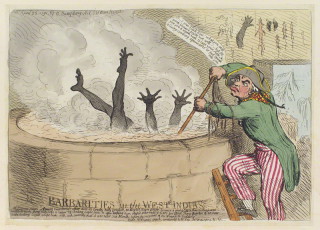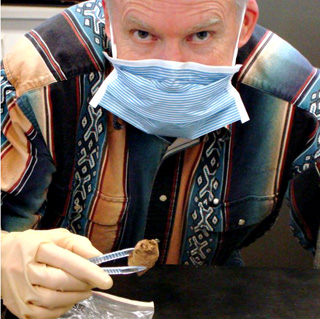
Henry Hobhouse’s book Seeds of Change: Five Plants That Transformed Mankind (now six, with the addition of cacao) contains the remarkable fact that at the height of the slave trade a single teaspoon of sugar cost six minutes of a man’s life to produce. Reason enough to cheer the abolition of slavery, I suppose. But that doesn’t mean that everything is sweetness and light in the business of sugar. Or salt. A photo gallery in The Big Picture made that very clear, and inspired Rachel Laudan, a food historian, to write in praise of industrial salt and sugar.
Podcast: Play in new window | Download (Duration: 17:02 — 8.1MB)
Subscribe: Google Podcasts | Spotify | Android | | More
One critic asked:
OK, I totally get why people should not live in poverty and desperation. But why does that translate into cheers for industrially processed foods? Don’t we actually consume more sugar and salt than we need to? How about something in between? Well made, fairly and sustainably produced. And consumed with reason.
Laudan makes a good case for industrial sugar and salt, although at the end she casually adds “rice, flour, wine, chocolate and many other foods we cherish”. Here, I think, is where we part company, because, unlike the critic quoted above, I want to distinguish foods from ingredients. On flour, for example, too right I don’t want to be grinding my own grain, as Rachel herself has made clear in much of her writing. But I also don’t want to be using only extremely industrial flour, and luckily I can afford to buy flour that is “well made, fairly and sustainably produced”. (“Consumed with[in] reason,” not so much.) At least I have the option. With very few exceptions, I cannot feel the same way about artisanal salt and sugar, although I confess that if I could get it easily, I would buy Maldon Sea Salt, and if I did, I would almost certainly eat more salt than I do at present.
I also feel, although I didn’t want to abuse my position as host and labour the point, that the very cheapness of sugar and salt does contribute to overconsumption. I’m pretty sure that the reason sugars, in all their forms, are cheap has more to do with subsidies and unpaid externalities than anything else, but whether getting rid of those would make a difference to consumption now, I have no idea. I doubt that it would make much difference to how much of either salt or sugar would be available for preserving.
Notes
- Cuisine and Empire: Cooking in World History, Rachel Laudan’s eagerly anticipated new book, will be published in September.
- Sugar has been the focus for many wonderful books, articles and the rest of it. Reading around for this episode I came across Mike Rendell’s website, which has some interesting historical insights. And ‘The Dunghill of the Universe’ The Sugar Barons: Family, Corruption, Empire and War looks worth a read too.
- The Food Programme, on BBC Radio 4, took a new look at Sugar: Pure, White and Deadly? — their question-mark, not mine — at the end of May. And pretty good it was too.
- Barbarities in the West Indies by James Gillray, published by Hannah Humphrey, hand-coloured etching, published 23 April 1791, copyright National Portrait Gallery and used with permission.
- Podcast cover image of Venezuelan cut sugarcane by Rufino Uribe.
- Intro music by Dan-O at DanoSongs.com.
 Bling, the Urban Dictionary tells me, is an onomatopoeic representation of light bouncing off a diamond. Or a Bob Kramer original hand-made chef’s knife, which goes for $2000 and up. Of course some people might be able to justify spending that kind of cash on what is, after all, one of the key tools of the trade … if your trade happens to be cooking. But my guest today, Peter Hertzmann, says he sees lots of knives, maybe not quite that expensive, hanging on the wall in people’s kitchens, unused. “Kitchen knives”, he told this year’s Oxford Symposium on Food and Cookery, are “the new bling”.
Bling, the Urban Dictionary tells me, is an onomatopoeic representation of light bouncing off a diamond. Or a Bob Kramer original hand-made chef’s knife, which goes for $2000 and up. Of course some people might be able to justify spending that kind of cash on what is, after all, one of the key tools of the trade … if your trade happens to be cooking. But my guest today, Peter Hertzmann, says he sees lots of knives, maybe not quite that expensive, hanging on the wall in people’s kitchens, unused. “Kitchen knives”, he told this year’s Oxford Symposium on Food and Cookery, are “the new bling”. 
 The Fertile Crescent, the Yangtze basin, Meso America, South America: those are the places that spring to mind as birthplaces of agriculture. Evidence is accumulating, however, to strengthen eastern North America’s case for inclusion. Among the sources of evidence, coprolites, or fossil faeces. Fossil human faeces. And among the people gathering the evidence Kris Gremillion, Professor of Anthropology at Ohio State University. She was kind enough to talk to me on the phone, and I made a silly mistake when I recorded it, so please bear with me on the less than stellar quality. I hope the content will see you through. And I’ll try not to let it happen again.
The Fertile Crescent, the Yangtze basin, Meso America, South America: those are the places that spring to mind as birthplaces of agriculture. Evidence is accumulating, however, to strengthen eastern North America’s case for inclusion. Among the sources of evidence, coprolites, or fossil faeces. Fossil human faeces. And among the people gathering the evidence Kris Gremillion, Professor of Anthropology at Ohio State University. She was kind enough to talk to me on the phone, and I made a silly mistake when I recorded it, so please bear with me on the less than stellar quality. I hope the content will see you through. And I’ll try not to let it happen again.
 I did not know that that the famous
I did not know that that the famous